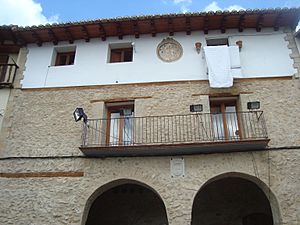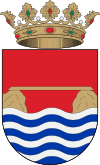Palanques facts for kids
Quick facts for kids
Palanques
|
||
|---|---|---|
 |
||
|
||
| Country | ||
| Autonomous community | ||
| Province | Castellón | |
| Comarca | Ports | |
| Judicial district | Vinaròs | |
| Area | ||
| • Total | 14.3 km2 (5.5 sq mi) | |
| Elevation | 670 m (2,200 ft) | |
| Population | ||
| • Total | 31 | |
| • Density | 2.17/km2 (5.61/sq mi) | |
| Demonym(s) | Palanqui, palanquina | |
| Time zone | UTC+1 (CET) | |
| • Summer (DST) | UTC+2 (CEST) | |
| Postal code |
12311
|
|
| Official language(s) | Valencian | |
Palanques is a very small town and municipality in Spain. It is located in the northern part of the Ports region, within the province of Castellón. This area is part of the Valencian autonomous community. In 2009, only about 35 people lived there. Palanques is also close to the town of Morella.
The main church in Palanques is dedicated to the Assumption of Mary. There is also a smaller church, called the Ermita de la Verge dels Dolors, which honors Our Lady of Sorrows. This small church is found within the town's area.
History of Palanques
Palanques was once a town settled by Moors, who were Muslim people from North Africa. This changed in the 13th century when James I of Aragon, a Christian king, conquered the nearby town of Morella. You can still see parts of an old tower in the town's main square today.
Population Changes Over Time
Palanques has seen its population shrink a lot over the last 100 years. In 1900, about 249 people lived there. By 1950, this number had grown to 1,133. However, after that, the population started to drop.
Many young people left traditional farming jobs, like growing crops without much water or raising sheep and goats. They moved to bigger cities like Barcelona or coastal areas of Castellón Province. They were looking for better jobs in factories and other industries. This led to a steady decline in the number of people living in Palanques.
By the year 2000, only 21 people lived in Palanques. Today, some of the old houses are in ruins. But many others have been fixed up and are used as summer houses. The town becomes lively again during the summer holidays. Many former residents return to enjoy the mild temperatures, especially the cool nights.
See also
In Spanish: Palanques para niños



